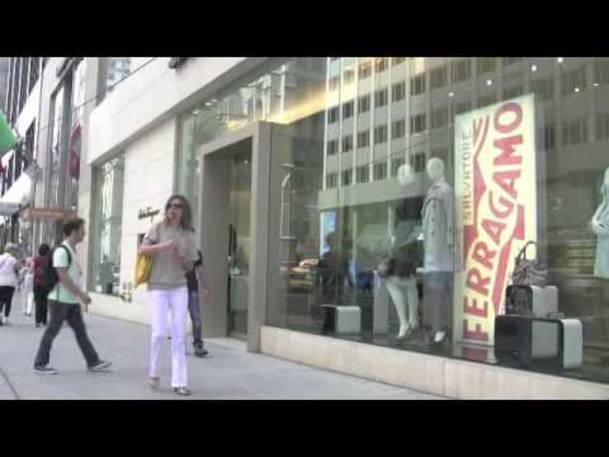


Despite claims that the economy was collapsing, Fifth Avenue during summer 2009 was as beautiful as ever. People strolled past the Armani [2] and Prada [3] stores in the blazing sun. Tourists posed for photos in front of Versace [4] and Fendi [5]. Display windows, stylishly arranged by creative minds, were vibrant and full of life. One has to look deeply into the behind the scenes world of fashion to detect signs of an economic crisis.
Though the fashion industry has indeed been hit hard by the wane of consumer shopping during recent months, the moda italiana sector has its head above water. In fact, the economic crisis is prompting fashion ownders and designers to be even more innovative and adopt strategic approaches in order to keep afloat and surpass the competition.
The 19th edition of the PREMIÈRE VISION PREVIEW NEW YORK was held on July 15 and 16, 2009 and was held at the Altman Building [6] in Chelsea. Anyone in
the Italian fashion business acknowledges the power of this event; it is the most important liaison between the Italian fashion industry and the United States. This exhibition provides the opportunity for companies to
review each other and present themselves on a commercial level to American
consumers and companies.
The participating companies from Italy were the most abundant in show and relevant, in terms of trendsetting for the next season. I-TEXSTYLE, a group organized by the Italian Trade Commission, was dedicated to presenting the foremost fabrics and styles of Italian collections for Winter 2010. In total 27 Italian companies exhibited, with an astounding number (12) of them coming from Lombardy, the fashion capital of Italy.
Due to the economic crisis, less vendors than usual were present at this year’s PREMIÈRE. There are typically over one hundred exhibitors, the 97 companies this year signaled the major cutbacks that companies are forgoing.
Despite it all, Italian ingenuity showed itself in diverse styles, fabrics, and also strategies by which fashion moguls achieve goals.
Some designers/owners believe the key to surviving the crisis is studying consumer trends. According to Angelo Uslenghi, Trends Committee Coordinator and Forecaster at Milano Unica [7], companies need to be more “marketing oriented,” and essentially curtail its line to the desires of its clients. Once a company assesses what is selling, it can focus in on that product or line and expand it. Luca Breschi, Vice Direttore di Generale Olmetex [8], agrees that companies need to focus on research that will promote work on products aimed to draw consumers’ attention.
Aniello Musella, director of the Italian Trade Commission, notes that Italian companies have invested a lot of research into new methods of working with materials and designs. He emphasizes that this economic crisis has been an opportunity for innovation. Pier Luigi Loro Piana, President of Milano Unica, says that the Italian fashion sector aims to maintain a stable level in the second part of 2009, with the prospect of that 2010 being a more optimistic year.
Many Italian fashion experts have been debating the idea of lowering prices. Michele Vigano`, CEO of Seterie Argenti [9], believes that lowering prices is an inadequate philosophy for the fashion business. Corrado Pedroni of Pizval [10] has also decided not to lower prices due to the temporary nature of the crisis. With lower prices in Italian fashion arrives an obvious downgrade of quality in products that are supposed to be the ideal the fashion industry.
Apparently, the commitment to quality design is a primary priority for most experienced top dogs in the Italian fashion industry. Companies want to keep their costumers happy, whether they are the upper echelon that typically frequents Fifth Avenue, or anyone that they take fashion seriously. The industry also thrives on crowds of tourists who are flock to Fifth Avenue, often seeking memorabilia of the Italian fashion mecca in NY. To lower prices and quality would degrade a large aspect of the moda italiana. Finding out what consumers are seeking and purchasing, and then incorporating those trends into the production stream, is critical for Italian companies.
Each season Italian companies flaunt their designs and innovations. Some of the new trends in this season include using colors inspired from nature: deep reds and yellows, earth tones, green grass after rain. Designers are using various shades of gray and silver, imperfect geometric patterns and fur. The flow of creativity in Italian fashion runs wild, and products are sure to push consumers’ buttons.
What it boils down to for most companies: do your homework, in the most business oriented sense. Companies must study the markets to understand what the consumers want and envision wearing. This is the key to surviving the crisis that will, with any luck, taper off with the start of 2010. Consumers: you seem to have the upper hand in this challenging moment in Italian fashion, because production of merchandise is curtailed to your demand.
Each day we make choices about what we put on our bodies. Buying designer clothing does not coincide with most people’s top priorities. One thing to consider is that when look good we tend to feel even better. On occasion, a well made and beautiful piece of designer clothing can brighten up someone’s wardrobe and outlook. It’s alright to treat ourselves to a gorgeous dress or suit that will last for years because of its quality. Plus it feels gratifying to walk into a designer shop and out with a chic bundle of Italian beauty.
Source URL: http://ftp.iitaly.org/magazine/focus/life-people/article/i-texstyle-one-tenacious-business-premiere-vision-preview-new
Links
[1] http://ftp.iitaly.org/files/ice-il-tessile-italiano-new-york
[2] http://www.armani5thavenue.com
[3] http://www.prada.com
[4] http://www.versace.com
[5] http://www.fendi.com
[6] http://www.altmanbldg.com
[7] http://www.milanounica.i
[8] http://www.olmetex.it
[9] http://www.argenti.it/
[10] http://www.pizval.com
[11] http://www.italtrade.com
[12] http://www.premierevision-newyork.com